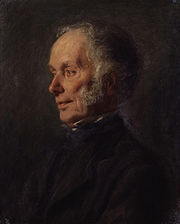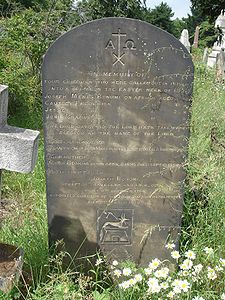
Joseph Bonomi the Younger
Encyclopedia

Egyptology
Egyptology is the study of ancient Egyptian history, language, literature, religion, and art from the 5th millennium BC until the end of its native religious practices in the AD 4th century. A practitioner of the discipline is an “Egyptologist”...
and museum curator
Curator
A curator is a manager or overseer. Traditionally, a curator or keeper of a cultural heritage institution is a content specialist responsible for an institution's collections and involved with the interpretation of heritage material...
.

Early life
Bonomi was born in London into a family of architects. His father, Joseph Bonomi the ElderJoseph Bonomi the Elder
Joseph Bonomi the Elder was an Italian architect and draughtsman notable for his activity in England.Born in Rome, he made his early reputation there, then moved to London in 1767....
, had worked with Robert
Robert Adam
Robert Adam was a Scottish neoclassical architect, interior designer and furniture designer. He was the son of William Adam , Scotland's foremost architect of the time, and trained under him...
and James Adam, while his older brother, Ignatius Bonomi
Ignatius Bonomi
Ignatius Bonomi was an English architect and surveyor, with Italian origins by his father, strongly associated with Durham in north-east England....
, was a notable architect of the early and mid-19th century.
The Hay expedition
In 1822, Bonomi went to RomeRome
Rome is the capital of Italy and the country's largest and most populated city and comune, with over 2.7 million residents in . The city is located in the central-western portion of the Italian Peninsula, on the Tiber River within the Lazio region of Italy.Rome's history spans two and a half...
to study under Antonio Canova
Antonio Canova
Antonio Canova was an Italian sculptor from the Republic of Venice who became famous for his marble sculptures that delicately rendered nude flesh...
, who died in October before Bonomi arrived. Nonetheless, Bonomi studied in Rome for several months but got into debt and was eventually happy to accept a modestly paid commission to accompany Robert Hay
Robert Hay (Egyptologist)
Robert Hay was a Scottish traveller, antiquarian, and early Egyptologist. He was born in Duns Castle, Berwickshire. During his service in the Royal Navy he visited Alexandria, Egypt, in 1818....
on an expedition, via Malta
Malta
Malta , officially known as the Republic of Malta , is a Southern European country consisting of an archipelago situated in the centre of the Mediterranean, south of Sicily, east of Tunisia and north of Libya, with Gibraltar to the west and Alexandria to the east.Malta covers just over in...
, to Egypt
Egypt
Egypt , officially the Arab Republic of Egypt, Arabic: , is a country mainly in North Africa, with the Sinai Peninsula forming a land bridge in Southwest Asia. Egypt is thus a transcontinental country, and a major power in Africa, the Mediterranean Basin, the Middle East and the Muslim world...
in 1824. This began a lifelong interest in Egyptology.
From 1824 to 1826, he was a member of Hay's expedition where he sketched many antiquities. At Abu Simbel
Abu Simbel
Abu Simbel temples refers to two massive rock temples in Abu Simbel in Nubia, southern Egypt on the western bank of Lake Nasser about 230 km southwest of Aswan...
in 1825, Bonomi – responding to Hay's demands for great accuracy – devised a drawing frame (a viewfinder-type device equipped with a sight and a string or wire grid) to help them draw the temples' interior decorations. The expedition then moved on to Kalabsha, where Bonomi laboured to produce several plaster casts of the reliefs, to Philae
Philae
Philae is an island in the Nile River and the previous site of an Ancient Egyptian temple complex in southern Egypt...
and then to Thebes.
However, Bonomi's relationship with Hay was stormy. Bonomi was frustrated at what he regarded as a low salary; Hay resented Bonomi's wish to enhance his own reputation by producing drawings and casts for himself. In July 1826, Bonomi resigned (and was replaced as Hay's assistant by Edward William Lane
Edward William Lane
Edward William Lane was a British Orientalist, translator and lexicographer....
).
In Cairo (1827–1828), Bonomi illustrated James Burton
James Burton (Egyptologist)
James Burton , formerly James Haliburton, was an early British Egyptologist, who worked at a number of sites throughout Egypt, but notably in the Valley of the Kings.-Life:...
's Excerpta hieroglyphica. In July 1832, with his finances now more stable, he met Hay again, at Asyut
Asyut
Asyut is the capital of the modern Asyut Governorate in Egypt; the ancient city of the same name is situated nearby. The modern city is located at , while the ancient city is at .- Etymology :...
, and was persuaded to rejoin his team (at a much higher salary) along with a French artist, Dupuy.
After Hay left Egypt in 1834, Bonomi undertook tours of Syria
Syria
Syria , officially the Syrian Arab Republic , is a country in Western Asia, bordering Lebanon and the Mediterranean Sea to the West, Turkey to the north, Iraq to the east, Jordan to the south, and Israel to the southwest....
and Palestine
Palestine
Palestine is a conventional name, among others, used to describe the geographic region between the Mediterranean Sea and the Jordan River, and various adjoining lands....
(with Francis Arundale
Francis Arundale
Francis Arundale , an architectural draughtsman, was born in London. He studied under Augustus Pugin, and accompanied him to Normandy, making drawings for a description which Pugin published of the tour. In 1831 Arundale visited Egypt with Mr...
and Frederick Catherwood
Frederick Catherwood
Frederick Catherwood was an English artist and architect, best remembered for his meticulously detailed drawings of the ruins of the Maya civilization. He explored Mesoamerica in the mid 19th century with writer John Lloyd Stephens...
). In 1839 he prepared illustrations for Sir John Gardiner Wilkinson's Manners and Customs of the Ancient Egyptians.
Architectural diversions

Abney Park Cemetery
Abney Park in Stoke Newington, in the London Borough of Hackney, is a historic parkland originally laid out in the early 18th century by Lady Mary Abney and Dr. Isaac Watts, and the neighbouring Hartopp family. In 1840 it became a non-denominational garden cemetery, semi-public park arboretum, and...
in Stoke Newington
Stoke Newington
Stoke Newington is a district in the London Borough of Hackney. It is north-east of Charing Cross.-Boundaries:In modern terms, Stoke Newington can be roughly defined by the N16 postcode area . Its southern boundary with Dalston is quite ill-defined too...
, London (in collaboration with William Hosking
William Hosking
William Hosking FSA was a writer, lecturer, and architect who had an important influence on the growth and development of London in Victorian times...
), built in Egyptian style with hieroglyphics signifying the Abode of the Mortal Part of Man. He also designed an Egyptian facade for John Marshall's Temple Works
Temple Works
Temple Works is a former flax mill in Holbeck, Leeds, West Yorkshire, England. It was designed by Joseph Bonomi the Younger and built by John Marshall between 1836 and 1840. Temple Works is the only Grade I listed building in Holbeck....
in Leeds
Leeds
Leeds is a city and metropolitan borough in West Yorkshire, England. In 2001 Leeds' main urban subdivision had a population of 443,247, while the entire city has a population of 798,800 , making it the 30th-most populous city in the European Union.Leeds is the cultural, financial and commercial...
(opened in 1841). The latter was undertaken shortly before Bonomi returned to Egypt as part of a Prussian expedition (1842–1844) led by Karl Richard Lepsius
Karl Richard Lepsius
Karl Richard Lepsius was a pioneering Prussian Egyptologist and linguist and pioneer of modern archaeology.-Background:...
. An 'Egyptian Spring' in Hartwell
Hartwell
Hartwell is a village in central Buckinghamshire, England. It is to the south of Aylesbury, by the village of Stone.The village name is Anglo Saxon in origin, and means "spring frequented by deer". In the Domesday Book of 1086 it was recorded as Herdeuuelle and Herdewelle.The ruined Hartwell...
, Buckinghamshire
Buckinghamshire
Buckinghamshire is a ceremonial and non-metropolitan home county in South East England. The county town is Aylesbury, the largest town in the ceremonial county is Milton Keynes and largest town in the non-metropolitan county is High Wycombe....
was designed by Bonomi in 1850 for Dr John Lee
John Lee (astronomer)
John Lee LL.D , born John Fiott, was an English philanthropist, astronomer, mathematician, antiquarian and barrister.-Family:...
of Hartwell House.
Work in England
On his return to England, Bonomi got married to Jessie, daughter of artist John MartinJohn Martin (painter)
John Martin was an English Romantic painter, engraver and illustrator.-Biography:Martin was born in July 1789, in a one-room family cottage, at Haydon Bridge, near Hexham in Northumberland, the 4th son of Fenwick Martin, a one time fencing master...
(1789–1854), in 1844. Now based in London, Bonomi's work included cataloguing and illustrating many Egyptian collections (including that of Samuel Birch
Samuel Birch
Samuel Birch was a British Egyptologist and antiquary.-Biography:Birch was the son of a rector at St Mary Woolnoth, London. He was educated at Merchant Taylors' School. From an early age, his manifest tendency to the study of out-of-the-way subjects well suited his later interest in archaeology...
); he also set up with Owen Jones
Owen Jones (architect)
Owen Jones was a London-born architect and designer of Welsh descent. He was a versatile architect and designer, and one of the most influential design theorists of the nineteenth century...
the Egyptian Court at The Crystal Palace
The Crystal Palace
The Crystal Palace was a cast-iron and glass building originally erected in Hyde Park, London, England, to house the Great Exhibition of 1851. More than 14,000 exhibitors from around the world gathered in the Palace's of exhibition space to display examples of the latest technology developed in...
for the Great Exhibition of 1851 and helped to arrange the Egyptian exhibits in the British Museum
British Museum
The British Museum is a museum of human history and culture in London. Its collections, which number more than seven million objects, are amongst the largest and most comprehensive in the world and originate from all continents, illustrating and documenting the story of human culture from its...
in London.

In 1861, Bonomi applied to become curator of the Sir John Soane's Museum. As this was normally a post awarded to a practising architect, he was only appointed after a fierce struggle and much criticism.
With his brother Ignatius, he built a house, The Camels, at Wimbledon
Wimbledon, London
Wimbledon is a district in the south west area of London, England, located south of Wandsworth, and east of Kingston upon Thames. It is situated within Greater London. It is home to the Wimbledon Tennis Championships and New Wimbledon Theatre, and contains Wimbledon Common, one of the largest areas...
in south-west London. He also invented a machine for measuring the proportions of the human body, and wrote a treatise, The Proportion of the Human Figure published in 1856.
Later life
He died in Wimbledon in March 1878 and was buried in Brompton CemeteryBrompton Cemetery
Brompton Cemetery is located near Earl's Court in South West London, England . It is managed by The Royal Parks and is one of the Magnificent Seven...
.http://www.brompton.org/Residents.htm
Personal life
He married Jessie Martin (6 April 1825 - 10 September 1859), daughter of the artist John MartinJohn Martin (painter)
John Martin was an English Romantic painter, engraver and illustrator.-Biography:Martin was born in July 1789, in a one-room family cottage, at Haydon Bridge, near Hexham in Northumberland, the 4th son of Fenwick Martin, a one time fencing master...
. They had twelve children, the first four of which died of whooping cough.

